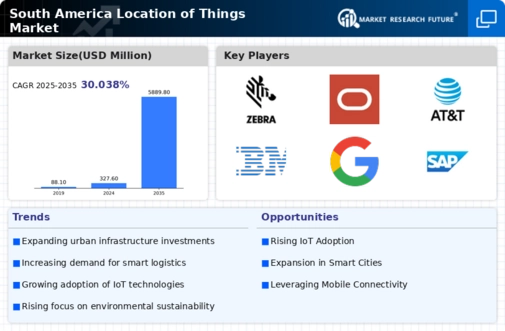Growth of E-Commerce and Delivery Services
The location of-things market is significantly influenced by the rapid growth of e-commerce and delivery services in South America. As online shopping becomes increasingly popular, businesses are compelled to adopt location-based technologies to enhance their delivery capabilities. The e-commerce sector in South America is expected to reach $100 billion by 2025, with a substantial portion of this growth attributed to the demand for efficient last-mile delivery solutions. Companies are leveraging location data to optimize routes, reduce delivery times, and improve customer satisfaction. This trend indicates that the location of-things market will play a crucial role in supporting the logistics and operational needs of the burgeoning e-commerce landscape.
Increased Focus on Urban Mobility Solutions
Urban mobility is a critical area of focus within the location of-things market in South America. As cities grapple with congestion and pollution, there is a growing emphasis on developing smart transportation solutions. The integration of location-based technologies into public transport systems is becoming essential for improving efficiency and user experience. For instance, cities are implementing real-time tracking of buses and trains, which enhances commuter convenience. The urban mobility market in South America is projected to grow by 15% annually, reflecting the increasing investment in smart city initiatives. This growth suggests that the location of-things market will be pivotal in shaping the future of urban transportation.
Rising Demand for Real-Time Tracking Solutions
The location of-things market in South America is experiencing a notable surge in demand for real-time tracking solutions. This demand is primarily driven by the need for enhanced logistics and supply chain management. Companies are increasingly seeking to optimize their operations by utilizing location-based technologies to monitor assets and inventory in real-time. According to recent data, the logistics sector in South America is projected to grow at a CAGR of 8.5% from 2025 to 2030, indicating a robust market for location-based services. Furthermore, the integration of GPS and RFID technologies is becoming commonplace, allowing businesses to improve efficiency and reduce operational costs. This trend suggests that the location of-things market will continue to expand as organizations prioritize real-time visibility in their operations.
Advancements in Location Analytics Technologies
The location of-things market is being propelled by advancements in location analytics technologies. These innovations enable businesses to derive actionable insights from location data, facilitating better decision-making processes. In South America, companies are increasingly adopting advanced analytics tools to understand consumer behavior and optimize operations. The market for location analytics is projected to grow at a CAGR of 12% over the next five years, indicating a robust demand for these technologies. As organizations seek to leverage data for competitive advantage, the location of-things market is likely to benefit from this trend, fostering a data-driven approach to business strategies.
Emergence of Location-Based Marketing Strategies
The location of-things market is witnessing a transformation due to the emergence of location-based marketing strategies. Businesses in South America are increasingly utilizing geolocation data to target consumers more effectively. This approach allows companies to deliver personalized advertisements and promotions based on a user's location, thereby enhancing customer engagement. Recent studies indicate that location-based marketing can increase conversion rates by up to 30%. As businesses recognize the potential of this strategy, the demand for location-based services is expected to rise. This trend highlights the importance of the location of-things market in driving marketing innovations and improving customer experiences.























Leave a Comment